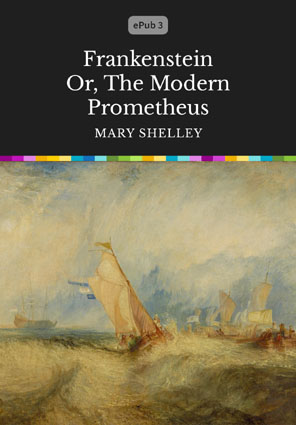I can think of few classic novels that have had such a widespread influence on both popular culture and literature as Mary Shelley’s “Frankenstein; Or, the Modern Prometheus”. Even if people haven’t read Shelley’s novel they have a sense of Doctor Frankenstein’s creation from the many films which have (mistakenly) portrayed him as a senseless monster. I even went to a show recently called Frankenstein: How to Make a Monster where talented young musicians from the BAC Beatbox Academy re-created the body of the monster in song as a way of describing terrifying issues and people they experience in everyday life. But Shelley’s characters, ideas and powerful story have also permeated the imaginations of so many novelists since the book’s initial publication in 1818. Most recently it’s been directly referenced and reimagined in the novels “Frankenstein in Baghdad” by Ahmed Saadawi and Jeanette Winterson’s latest novel “Frankissstein”. Winterson’s novels have always had strong ties to the work of past writers (most notably Virginia Woolf) but her recent novels more strongly incorporate this influence such as her remix of The Winter’s Tale in her novel “The Gap of Time”.
“Frankissstein” goes a step further creating a dual narrative which switches back and forth between a historical section where we see Mary Shelley writing her famous novel and a near future where a non-binary individual named Ry Shelley engages in a complicated romantic relationship with a secretive scientist named Professor Stein. The historical sections have a more philosophical feel as Mary engages in meaningful discussions with her husband, the poet Byron and other interesting figures from the time period. The modern section is much more playful as it initially begins at a convention where a madcap capitalist named Ron promotes the use of his advanced range of sexbots designed to suit everyone’s emotional and physical needs. There’s even a Germaine Greer sex doll! Meanwhile, Professor Stein gives a lecture about the future of humans in a post-human world and engages in some edgy scientific experimentation. While the tone of these two narrative threads sound totally at odds with each other they feel strangely cohesive – especially as the novel increasingly becomes concerned with questions about the advancement of our species, the meaning of consciousness and the complicated dynamics of love: “Love is not a pristine planet before contaminants and pollutants, before the arrival of Man. Love is a disturbance among the disturbed.” The novel also has a political edge engaging with issues to do with feminism, gender identity, ethics and Brexit.
One of Winterson’s greatest talents is mixing an ardent seriousness in her writing with a richly playful sensibility to form stories that are both engaging and deeply poignant. Initially I felt more emotionally engaged by Mary’s 19th century tale and her struggles with marriage, friendship, money and nationality. But as the story progressed I became more attached to the character of Ry (whose shortened name could be a part of the names Mary or Ryan.) Ry encounters prejudice because of their gender identity and also develops a strong sexual connection and relationship with Professor Stein who is frustrated because falling for Ry wasn’t a part of his plan. Both Mary and Ry find themselves oddly positioned in relation to men whose grandiose ideas about mankind’s advancement don’t encompass matters to do with the human heart. In a sense, Mary and Ry are a continuation of the same person who has changed through the centuries like Woolf’s “Orlando”. In this way Winterson brilliantly messes with the perceived linear nature of time and the way certain issues emerge continuously amidst society’s progression: “Our lives are ordered by the straight line of time, yet arrows fly in all directions. We move towards death, while things we have scarcely understood return and return wounding us for our own good.”
The novel also considers ideas about storytelling itself - both in forming fictional narratives and the narrative of history. Mary Shelley was in the unusual position of producing a brilliant novel so early in her life and its themes go on to haunt her as Winterson shows how her life plays out in subsequent years. I like how Winterson considers how oddly abstract experience becomes when it’s formed into a story: “Only in the living of it does life seem ordinary. In the telling of it we find ourselves strangers among the strange.” But I also appreciate how she confronts popular notions of nationalism and that the idea of Britishness is just another story we’re telling ourselves: “The timeless serenity of the past that we British do so well is an implanted memory – you could call it a fake memory. What seems so solid and certain is really part of the ceaseless pull-it-down-build-it-again pattern of history, where the turbulence of the past is recast as landmark, as icon, as tradition, as what we defend, what we uphold – until it’s time to call in the wrecking ball.” I think this notion is good to keep in mind when any politician cites historical references to support their own ideological campaigns.
While I like to linger on many lines in Winterson’s novels (she’s a very quotable author) because she can poignantly encapsulate powerful ideas in few words, sometimes these grand statements pull me out of the flow of the story. The point of view can at times feel more like Winterson’s rather than her characters. There’s also occasional clunky lines such as a discussion about feminism where Mary self-consciously names her mother in a way that’s more for the reader’s benefit rather than for the characters she’s conversing with: “My mother, Mary Wollstonecraft, would not agree with you, I said.” Yet, these are minor quibbles I had with a novel I so thoroughly admire and enjoyed. I like reading novels which aren’t afraid to converse so self-consciously with stories that have come before. I think “Frankissstein” does this artfully while making a tale that is entirely new and immensely fun to read.













